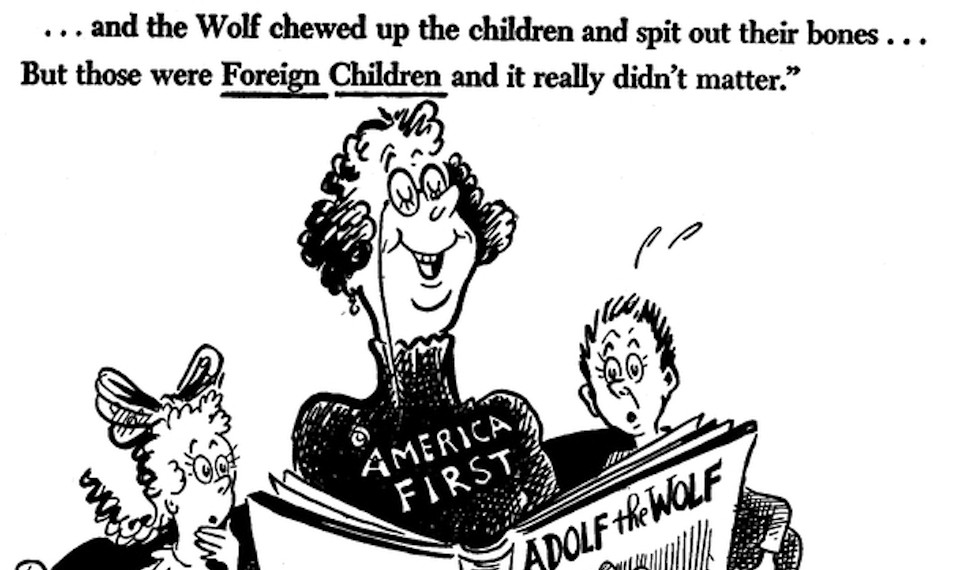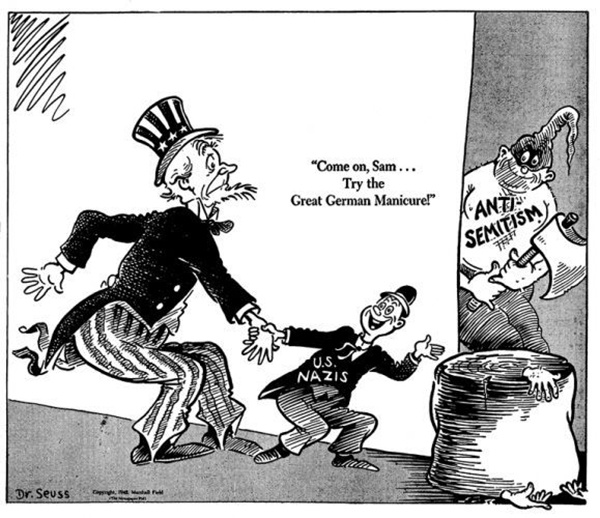…

Of all the significant cultural figures finding new relevance during a turbulent news cycle, one of the more intriguing is Dr. Seuss. The German American cartoonist and author, born Theodor Seuss Geisel, is best known for his children’s books, The Cat in the Hat, The Lorax, and Horton Hears a Who among them. But for two years starting in 1941, Geisel worked as a political cartoonist for the liberal New York newspaper PM, crafting more than 400 cartoons on the subject of World War Two. One of these in particular, a drawing lampooning the non-Interventionist America First movement, has been reemerging recently amid protests against President Trump’s executive order barring immigrants and refugees from seven Muslim-majority countries.
The cartoon, which mocks an apparent blithe naiveté about the dangers posed by Nazi Germany, as well as a callousness regarding the lives of children who aren’t American citizens, makes it a striking accompaniment to modern protests, not least of which is that Trump has named one of his own official platforms “America First.” As a collection, Geisel’s war cartoons target isolationism, anti-Semitism, and racism. They skewer Hitler, Mussolini, and a variety of American nationalists, including Charles Lindbergh and the Catholic priest and radio host Father Charles Coughlin, a fervent anti-Semite and conspiracy theorist. But they also deploy a fierce anti-authoritarianism and humanism that runs through all of Dr. Seuss’s books. Geisel’s political cartoons go a long way in demonstrating how the spirit of Seuss—zany, honest, brash, and brave—was born.
They also have their own flaws, most notably their racist portrayal of both Japanese citizens and Japanese Americans. Geisel’s bigoted treatment of both only a few months before the forced internment of Japanese Americans was something many believe he tried to atone for in his later books. But the body of work he created during the war helped establish the foundations of what the writer Philip Nel has described as “America’s first anti-Fascist children’s writer.” And it helps explain why Dr. Seuss continues to resonate now, more than 25 years after his death, and as American nationalism gains momentum once again.*
According to Dr. Seuss Goes to War, Richard H. Minear’s 1999 book on Geisel’s editorial cartoons, PM was founded as an outspoken liberal publication, free of advertising, and funded by its five-cent purchase price. Ralph Ingersoll, its founder, described part of the paper’s mission as opposing “people who push other people around just for the fun of pushing, whether in this country or abroad.” Sometime around January 1941, Geisel drafted his first political cartoon and showed it to a friend who worked at PM, who passed it on to Ingersoll. It depicted Virginio Gayda, an Italian journalist and Fascist whom many saw as a mouthpiece for the dictator Benito Mussolini, beating furiously at the keys of a steam-emitting typewriter, all while suspended from a hook behind him. Geisel attached a note about Gayda with the cartoon that read, “Almost every day, in amongst the thousands of words that he spews forth, there are one or two sentences that, in their complete and obvious disregard of fact, epitomize the Fascist point of view.”

By May 1941, Geisel was publishing as many as seven cartoons a week in PM, and many of his most impassioned works came during this time, in the months leading up to the attack on Pearl Harbor. One drawing, published in April, depicted a coin featuring an ostrich burying its head in the sand, inscribed as “The Lindbergh Quarter.” Another published the next day showed Americans standing in line to purchase their own ostrich hats, guaranteed to relieve “Hitler headache.” The caption: “We always were suckers for ridiculous hats.”
Geisel’s antipathy toward anti-interventionists possibly stemmed from his German-American upbringing in Springfield, Massachusetts, and his circle of friends in New York. Minear told me that in 1976, Geisel wrote a note responding to an interview request from Dartmouth College, saying, “I believed the USA would go down the drain if we listened to the America-First-isms of Charles Lindbergh and Senators Wheeler and Nye, and the rotten rot that the Fascist priest Father Coughlin was spewing out on radio. I, probably, was intemperate in my attacks on them. But they almost disarmed this country at the time it was obviously about to be destroyed.”
Geisel took aim at Hitler and Mussolini, at Lindbergh, and particularly at America First adherents, whom he saw as turning a willful blind eye to the dangers posed by Hitler’s Fascist regime, or even directly associating themselves with Nazism. One cartoon, “The Isolationist,” even featured a limerick, accompanying a drawing of a whale suspending himself “safely” on top of a mountain, out of water, and thus out of danger. It reads, “Said a whale, ‘There is so much commotion/Such fights among fish in the ocean/I’m saving my scalp/Living high on an Alp/(Dear Lindy! He gave me the notion!)”
But after Pearl Harbor, Geisel’s cartoons became more overtly opposed to Japan, and more crude in style. He depicted Hideki Tojo, the Prime Minister and Supreme Military Leader of Japan, as an ugly stereotype, with squinting eyes and a sneering grin. In February 1942, he drew a long line of Japanese Americans on the Pacific Coast of the U.S. collecting blocks of TNT from a kiosk labeled “Honorable 5th Column,” with one pointing a telescope across the ocean. The caption read, “Waiting for a signal from home.”

It’s more than a little baffling now to see Geisel, who’d railed repeatedly against racism, Jim Crow, and anti-Semitism in his cartoons, proffer up such bigoted depictions of Asians both in the U.S. and overseas. “We all have blind spots,” Minear told me. “I use that as a teaching moment—even Dr. Seuss went astray.” In his book, Minear also points out that such sentiment was common in the New York circles Geisel moved in at the time. Although there were reader complaints about drawings he made mocking dachshunds, and the pacifist John Haynes Holmes, there were no letters recorded objecting to his treatment of Asians.
Minear believes, though, that Geisel tried to make up for his earlier prejudice in later works. “Horton Hears a Who came after a trip to Japan, and is easy to read allegorically,” he told me. “The people of Whoville are Japan, Vlad Vladikoff is Russia, Horton is us/democracy, etc.” Geisel supposedly came up with the idea for Horton, in which an elephant discovers a microscopic universe, on a trip to Japan, and dedicated the 1954 book to a Japanese friend. The theme of the story, that “a person’s a person no matter how small,” seems to offer a note of contrition for jingoistic wartime expressions. In the 1980s, too, according to the writer Donald E. Pease, Geisel scanned his earlier books for racial stereotypes, and altered a reference to a “yellow-faced Chinaman who eats with sticks” in And to Think That I Saw It on Mulberry Street.
Horton isn’t the only book that echoes themes explored in Geisel’s political cartoons. Minear thinks that almost all of his later books (with the exception of the ones designed as reading aids) are political in some way or another. The Lorax is an obvious parable about environmentalism. The Sneetches and Other Stories includes an absurd fable about strange yellow creatures, half of whom have stars on their bellies and discriminate against the other half, and vice versa. The Butter Battle Book seems particularly potent today, with its tales of the Yongs and the Zooks, who live on either side of a vast wall, and hate each other because of the different ways they eat their bread and butter. The two sides create increasingly inventive and destructive weapons to fire over the wall until both come up with a device called the Bitsy Big-Boy Boomeroo, which means mutually assured destruction should it ever be fired. The book ends with a standoff, with both sides waiting to see what the other does. It’s a message to children made explicit in what Geisel wanted his last words to be, which he told his biographers, Judith and Neil Morgan, were: “We can and must do better than this!”

Then there’s Yertle the Turtle, a book of stories whose title character is the king of the pond, a ruthless authoritarian who demands that the other turtles stack themselves on top of each other so he can ascend to the top and get a better view. Yertle, who ignores the pain of his underlings, is finally bested by a burp, in a suitably absurd revolution. In the first drawing of him, Minear says, Geisel gave Yertle a Hitler mustache. But now Minear sees another figure in him. Between the narcissism nd the arrogance, he says, Yertle “is Trump 50 years ago.”

Little surprise, then, that Geisel’s cartoons, political and non, are finding a new audience now, as protests ramp up against the 45th president, whose affects and actions are at times as recognizable and cartoonish as Dr. Seuss’s characters. It’s hard not to assume Geisel would be cheered by seeing his work inspire signs and memes and viral tweets. “Humor has a tremendous place in this sordid world,” he once said. “It’s more than just a matter of laughing. If you can see things out of whack, then you can see how they can be in whack.”
No comments:
Post a Comment